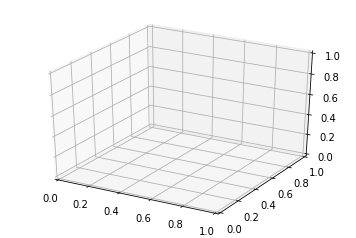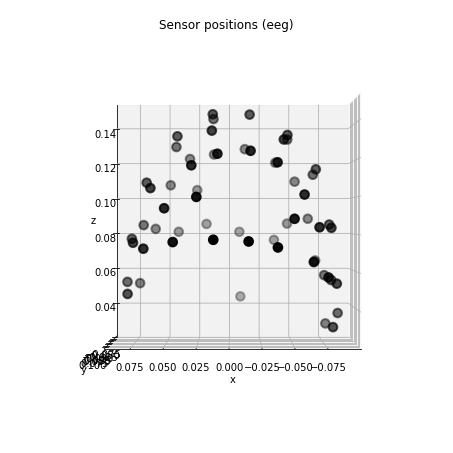%matplotlib inline
The Info data structure
The Info data object is typically created
when data is imported into MNE-Python and contains details such as:
- date, subject information, and other recording details
- the sampling rate
- information about the data channels (name, type, position, etc.)
- digitized points
- sensor–head coordinate transformation matrices
and so forth. See the the API reference
for a complete list of all data fields. Once created, this object is passed
around throughout the data analysis pipeline.
mne.Info behaves as a nested Python dictionary:
import mne
import os.path as op
# Read the info object from an example recording
info = mne.io.read_info(
op.join(mne.datasets.sample.data_path(), 'MEG', 'sample',
'sample_audvis_raw.fif'), verbose=False)
List all the fields in the info object
print('Keys in info dictionary:\n', info.keys())
Keys in info dictionary:
dict_keys(['file_id', 'events', 'hpi_results', 'hpi_meas', 'subject_info', 'hpi_subsystem', 'proc_history', 'meas_id', 'experimenter', 'description', 'proj_id', 'proj_name', 'meas_date', 'sfreq', 'highpass', 'lowpass', 'line_freq', 'gantry_angle', 'chs', 'dev_head_t', 'ctf_head_t', 'dev_ctf_t', 'dig', 'bads', 'ch_names', 'nchan', 'projs', 'comps', 'acq_pars', 'acq_stim', 'custom_ref_applied', 'xplotter_layout', 'kit_system_id'])
List all information about the first data channel
print(info['chs'][0])
{'scanno': 1, 'logno': 113, 'kind': 1, 'range': 0.00030517578125, 'cal': 3.1600000394149674e-09, 'coil_type': 3012, 'loc': array([-0.1066 , 0.0464 , -0.0604 , -0.0127 , 0.0057 ,
-0.99990302, -0.186801 , -0.98240298, -0.0033 , -0.98232698,
0.18674099, 0.013541 ]), 'unit': 201, 'unit_mul': 0, 'ch_name': 'MEG 0113', 'coord_frame': 1}
Obtain the sampling rate of the data
print(info['sfreq'], 'Hz')
600.614990234375 Hz
Obtaining subsets of channels
There are a number of convenience functions to obtain channel indices, given
an mne.Info object.
Get channel indices by name
channel_indices = mne.pick_channels(info['ch_names'], ['MEG 0312', 'EEG 005'])
Get channel indices by regular expression
channel_indices = mne.pick_channels_regexp(info['ch_names'], 'MEG *')
Channel types
MNE supports different channel types:
- eeg : For EEG channels with data stored in Volts (V)
- meg (mag) : For MEG magnetometers channels stored in Tesla (T)
- meg (grad) : For MEG gradiometers channels stored in Tesla/Meter (T/m)
- ecg : For ECG channels stored in Volts (V)
- seeg : For Stereotactic EEG channels in Volts (V).
- ecog : For Electrocorticography (ECoG) channels in Volts (V).
- fnirs (HBO) : Functional near-infrared spectroscopy oxyhemoglobin data.
- fnirs (HBR) : Functional near-infrared spectroscopy deoxyhemoglobin data.
- emg : For EMG channels stored in Volts (V)
- bio : For biological channels (AU).
- stim : For the stimulus (a.k.a. trigger) channels (AU)
- resp : For the response-trigger channel (AU)
- chpi : For HPI coil channels (T).
- exci : Flux excitation channel used to be a stimulus channel.
- ias : For Internal Active Shielding data (maybe on Triux only).
- syst : System status channel information (on Triux systems only).
Get channel indices by type
channel_indices = mne.pick_types(info, meg=True) # MEG only
channel_indices = mne.pick_types(info, meg=False, eeg=True) # EEG only
MEG gradiometers and EEG channels
channel_indices = mne.pick_types(info, meg='grad', eeg=True)
Get a dictionary of channel indices, grouped by channel type
channel_indices_by_type = mne.io.pick.channel_indices_by_type(info)
print('The first three magnetometers:', channel_indices_by_type['mag'][:3])
The first three magnetometers: [2, 5, 8]
Obtaining information about channels
Channel type of a specific channel
channel_type = mne.io.pick.channel_type(info, 75)
print('Channel #75 is of type:', channel_type)
Channel #75 is of type: grad
Channel types of a collection of channels
meg_channels = mne.pick_types(info, meg=True)[:10]
channel_types = [mne.io.pick.channel_type(info, ch) for ch in meg_channels]
print('First 10 MEG channels are of type:\n', channel_types)
First 10 MEG channels are of type:
['grad', 'grad', 'mag', 'grad', 'grad', 'mag', 'grad', 'grad', 'mag', 'grad']
Dropping channels from an info structure
It is possible to limit the info structure to only include a subset of
channels with the mne.pick_info function:
# Only keep EEG channels
eeg_indices = mne.pick_types(info, meg=False, eeg=True)
reduced_info = mne.pick_info(info, eeg_indices)
print(reduced_info)
<Info | 24 non-empty fields
acq_pars : str | 13886 items
bads : list | 0 items
ch_names : list | EEG 001, EEG 002, EEG 003, EEG 004, EEG 005, EEG 006, ...
chs : list | 59 items (EEG: 59)
comps : list | 0 items
custom_ref_applied : bool | False
description : str | 49 items
dev_head_t : Transform | 3 items
dig : list | 146 items
events : list | 1 items
experimenter : str | 3 items
file_id : dict | 4 items
highpass : float | 0.10000000149011612 Hz
hpi_meas : list | 1 items
hpi_results : list | 1 items
lowpass : float | 172.17630004882812 Hz
meas_date : tuple | 2002-12-03 19:01:10 GMT
meas_id : dict | 4 items
nchan : int | 59
proc_history : list | 0 items
proj_id : ndarray | 1 items
proj_name : str | 4 items
projs : list | PCA-v1: off, PCA-v2: off, PCA-v3: off
sfreq : float | 600.614990234375 Hz
acq_stim : NoneType
ctf_head_t : NoneType
dev_ctf_t : NoneType
gantry_angle : NoneType
hpi_subsystem : NoneType
kit_system_id : NoneType
line_freq : NoneType
subject_info : NoneType
xplotter_layout : NoneType
>
Exercises
1) Can you plot the EEG sensors in the info?
import matplotlib.pyplot as plt
from mpl_toolkits.mplot3d import Axes3D
fig = plt.figure()
ax = fig.add_subplot(111, projection='3d')
# your code here to compute x, y, z
# ax.scatter(x, y, z)

In fact, you can use a convenient method raw.plot_sensors to just do this.
# % matplotlib notebook
data_path = op.join(mne.datasets.sample.data_path(), 'MEG',
'sample', 'sample_audvis_raw.fif')
raw = mne.io.read_raw_fif(data_path, preload=True).pick_types(eeg=True, meg=False)
raw.plot_sensors(kind='3d');
Opening raw data file /local_mount/space/meghnn/1/users/mjas/mne_data/MNE-sample-data/MEG/sample/sample_audvis_raw.fif...
Read a total of 3 projection items:
PCA-v1 (1 x 102) idle
PCA-v2 (1 x 102) idle
PCA-v3 (1 x 102) idle
Range : 25800 ... 192599 = 42.956 ... 320.670 secs
Ready.
Current compensation grade : 0
Reading 0 ... 166799 = 0.000 ... 277.714 secs...
